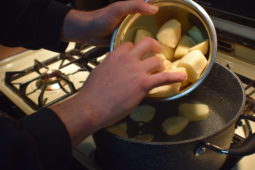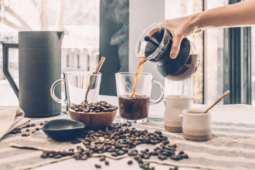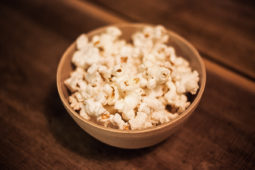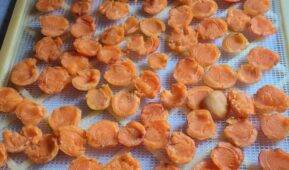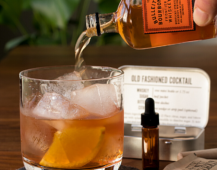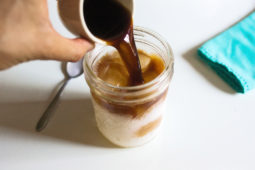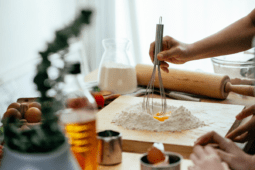30 Things Every Man Should Know About Wine

The existence of wine predates the written language and for good reason. At ManMade, we take our wine-loving and appreciation seriously, so we partnered with our brothers at Murphy-Goode Winery to bring you the essential things we believe every man should know about wine. It’s Murphy-Goode’s 30th anniversary (their Maniversary), so we thought we’d share thirty tips, ideas, and bits of trivia to celebrate. Here we go:
Just a Little Wine History (aka ‘Conversation Starters’)

How Wine Bottles Got Their Shape
Wine bottles were shorter and more bulbous until the end of the 17th century when cork became the best method for sealing. Since cork naturally dries out and often breaks into small pieces tainting the flavor, wine bottles began being stored on their side, and as a result, the shape of the bottle became taller and thinner.
DIY Prohibition Wine
You’ve gotta hand it to humanity’s ingenuity. During prohibition a handful of US grape juice manufacturers labeled their bottles with wine-making instructions, masked with the slightest veneer of a warning, such as: “CAUTION! Do not add these grapes to five gallons of water and five pounds of sugar with yeast, or it will ferment into wine, which is ILLEGAL.”

Why Wine Bottles Are Different Colors
Typically dark green bottles are used for reds, light green for dry whites, and colorless bottles for sweet wines. This is because sunlight can break down the tannins and antioxidants you want to keep in the wine, and makes them oxidize prematurely. Dark glass tends to decrease the odds of oxidation and increase the storage life.
The Brits invented the dark green bottle color.
A specific Brit in fact: Sir Kenelm Digby, a 17th century philosopher and diplomat who discovered the benefits of darker colored glass while operating his family’s glassworks.
The 2004 Academy-Award winning film Sideways crushed the Merlot market.
Audiences fell in love with Paul Giamatti’s character, who notoriously hated Merlots (“Pour any Merlot and I’m leaving”), and subsequently joined in his distain. At the same time, the market for Pinot Noirs skyrocketed, in keeping with the character’s taste.
The Basic Wines You Need to Know:

Reds:
The crowned king of red wine grape families because of the wide variety of wines it can yield. The best Cabernet Sauvignons come from Bordeaux and from California and are known for their full-bodied flavors. Typical Cabernet Sauvignon descriptions read like the 2012 Poker Knight Cab from Murphy-Goode which “opens up with aromas of vanilla and a sweet smoky and toasty character that leads into wonderful berry fruits. Flavors of blueberry, blackberry, and dark chocolate are framed by velvety tannins and finished with a long aftertaste of mocha and black cherries.” Cabernet Sauvignon is best paired with a simple and hearty meat like a slow roasted beef tenderloin or grilled flank steak. Like Chardonnay, the Cab flourishes over time in oak barrels and is therefore one of the best wines to age.
Considered the more approachable sister of the Cabernet Sauvignon, Merlot is currently the most popular wine in the world. It’s known for its variety of red fruit elements such as cherry, raspberry, plum, currant, and often just a slight hint of vanilla or cedar/oak. Merlots pair wonderfully with a rosemary chicken or a homemade tomato sauce.
If Merlot is approachable and Cabernet Sauvignon is stable, then Pinot Noir is sensual and exotic. Known for its dark fruit character matched with bright acidity and flavor, the Pinot Noir’s spicy bouquet pairs best with your favorite pulled pork sandwich or some cedar plank steak hot off the grill.
Syrah/Shiraz:
While the flavors of each of these wines will vary quite a bit, Syrah is best known for the usual flavors of dark berries, violet, tobacco, earth, pepper, and spice. The grapes for Syrah grow all over the world, most notably in the Rhone Valley of France, Washington State, and Australia (where it is known as Shiraz). Good to pair with lamb or venison.

Whites:
The most popular white wine in the world (and also the most popular wine, period) is Chardonnay. It’s made in nearly every wine-producing region in the world. Some Chardonnays will have a crisp, fresh taste of pear or apple, whereas other bottles will be aged in oak barrels infusing them with a creamy or buttery texture and complex notes of vanilla and spice. Chardonnay pairs well with light fish or calamari, but also makes the perfect wine to casually sip after a long day.
Similar to Chardonnay, Pinot Grigio is a dry, refreshing wine that is meant to be enjoyed while it’s still young. The most notable aromas are pear, apple, lemon, and mineral, although some – like the 2013 Pinot Grigio from Murphy-Goode – also boast hints of white peach and just a touch of spice. It’s a perfect compliment for fish tacos or as a stand-alone party drink.
Sauvignon Blanc derives its name from the French word for “wild” because of the rigor and delicacy with which the grapes must be tended to produce the nuanced flavors that define it. While containing the standard white wine aromas of citrus fruit and melon, Sauvignon Blanc often contains a balanced flavor of grassiness or hay that compliments the usual notes.
Riesling
Riesling is one of the “noble” grape varieties and can produce a wide range of white wines, although it is most recognized for the sweeter German-style wines it makes. However, it’s a common misconception that Reislings are always sweet. Riesling often boasts a floral aroma with notes of honey, apricot, and peach, and is considered the opposite of Chardonnay as it is rarely aged with oak.
Here’s How To Talk About Wine

Tannin is a naturally occurring element in plants, seeds, bark, fruit skins, and leaves that is credited for making wine taste dry. In reality, it doesn’t affect the taste as much as the physical sensation of astringency that makes your mouth feel dry. Tannin is a natural preservative that dissipates through the wine as it matures and softens the taste.
Wine Weight and Body
The weight of a wine correlates to its alcohol content. Whereas the “body” of a wine (aka: how it feels in your mouth) is a combination of both the alcohol content and the general fruitiness of the wine. The more alcohol, the warmer and fuller the feeling in your mouth.
Wine Finish
A wine’s finish is the last impression left on your tongue after swallowing the wine. Typically white wines will have clean, crisp finishes, while younger reds will last longer but still end with a single, linear cutoff. An older or more expensive red, however, will often unpack a series of evolving notes over the course of 45 seconds or more, growing exceeding more complex before disappearing.

Other Wine Terms
The term “fruit-forward” is used to describe wines that are refreshing and easy to drink with soft tannins and fruity flavors. The term “old world” as applied to wines refers to the traditional wines produced in western European countries like France, Germany, and Italy. The term “new world” refers to wines produced in countries that challenge the traditional methods by promoting wines made from grapes picked at peak ripeness, such as those coming out of Australia and Chile.
The warmer the climate, the sweeter the wine.
Sort of. Generally speaking, grapes grown in warmer climates tend to create fruiter, more complex tasting wines. Californian wines and those made from New Zealand grapes where the sun is often shining tend to have sweeter flavors than wines that come form climates with a broader range of weather, like Spain and France.
How To Incorporate Wine at Your Next Dinner Party
Beer doesn’t have to be the only thing at the BBQ.
It’s true. We wrote a whole post series about it. The best wines for BBQ’s are both fruity and spicy to counterbalance the char of the grill. Zinfandels are nice, although Murphy-Goode Winemaker, David Ready Jr., who’s a huge barbecue fan, claims “there is no finer food-and-wine match than Murphy-Goode Cabernet Sauvignon with a grilled beef filet topped with crumbled blue cheese.”
Beauty before age
As a general dinner party rule, it’s better to serve younger wines before older wines, drier wines before sweeter wines, and lighter-bodied wines before fuller-bodied wines.

The best wines for picnics tend to have lower alcohol contents and should be refreshingly light like a nice Riesling or Rosé. Be sure to chill them beforehand if you’ll be out in the warm summer sun; your special someone will think you’re quite the planner.
We’ve all been told to pair white wines with fish and light dishes and red wines with red meat, and that’s pretty much still true. The key is to match the wine with the dominant flavor of the dish. For example a grilled fish might go best with a Sauvignon Blanc, but would pair better with a Chardonnay if topped with a thick, creamy sauce. Ultimately though, it comes down to whatever you prefer.

The red wine spectrum. Pair hearty dishes with heavier wines like Cabernet Sauvignon, and comfort foods like pizza and hamburgers with Zinfandel or Merlot.
For a lot of men, it seems like a good idea to have a bottle of wine at home at all times so that you’ll never need to duck out to a store when you’re running late for a party. For that, I’d recommend having a good Pinot Noir. It’s a popular, solid staple that will go well with a range of foods that don’t need to be hearty (but could be), and its versatility means it’s great for an afternoon BBQ or an impromptu late night date.
How To Buy and Serve Wine

Serving Temperature
Don’t serve red wine at room temperature, especially on a hot day. Anything above 70 degrees is just too warm. Just pop that bottle in the fridge for 30 minutes before serving and you’ll notice a quality difference immediately.

Don’t Overlook Blends
Wines made from a variety of grapes are not just the leftovers from the better single grape varieties. They’re a great way for winemakers and craftspeople to put a person spin on their products, and show off their skills. Many classic, old world wines are blends: Bordeaux, Chianti, Bourgogne, Rhone, Rioja, even Champagne and Cava. New world blends from modern winemakers are in the same family, and offer excellent flavor and value.

Storing Wine
Wine should always be stored in a cool, dark room with a consistent temperature. The ideal temperature is 50-55 degrees, so basements are usually good as long as the temperature doesn’t fluctuate too much. Store wine on its side, so that the cork will stay saturated with liquid and not dry out.
Aging wine can be a fun hobby, but it’s better to drink wine too early than too late. Most wines are best consumed within the first five years of manufacture.

Decanting
Decanting, a process for separating mixtures, is up for debate in wine circles. A good argument in favor of decanting with older wines (in particular) is that over time, sediment from the eventual breakdown of tannins and pigments tend to gather; decanting will help break that up. Also, with older wines, decanting can bring out some of the fruiter sides of a wine that may shift to a muskier aroma with age. It’s helpful to pour slowly through a decanter (so you don’t overexpose the wine).
Open It Early
The best thing you can do for any bottle of red wine is to open it a few hours before you plan to drink it. Even if you don’t have a decanter, the exposure to air here allows the wine to “breathe” and results in a richer, more nuanced experience. This is also a great trick to helping inexpensive wine drink much more like a pricier bottle.

Wine glasses should be held by the stem. The stem was designed to be held so that your hands won’t affect the wine’s temperature within the glass. Two fingers and a thumb are all you need. If your glass is too heavy for that light grip, you’ve got too much in the glass.
Use the right glass.
Complex aromas with multiple notes (such as those found in red wines) are easier to detect and enjoy when experienced with a wide glass. The wider bowl of the red wine glass is intentionally made to draw out these distinctive traits, while the narrower glass for white wines help compliment the natural aromas of white wines.
The End
That’s it! As with any list that presents itself as definitive, take everything with a grain of salt. Sommeliers (the professional wine experts you see parodied so often in movies) go through years of schooling to develop their taste, and while you can totally do that, all you need to develop an evolved palate is a dedication to discovery and a willingness to depart from the mainstream.
This post was sponsored by Murphy-Goode Winery. Thanks for supporting the sponsors who support ManMade!


